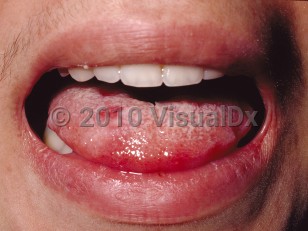Behçet disease is relatively uncommon and is more prevalent in Japan and Middle Eastern and Mediterranean countries. While Behçet disease has an equal sex distribution overall, there is male predominance in Middle East and Mediterranean patients and female predominance in Japan and Korea. Severe disease is more commonly seen in males. The onset of symptoms typically occurs during the third or fourth decades of life. Rarely, it can present during childhood, and usually in children with a positive family history of the syndrome. Behçet disease is strongly associated with the HLA-B51 allele, which is present in more than 80% of Asian patients with Behçet disease.
Clinically, Behçet disease is characterized by recurrent oropharyngeal and genital ulcers and ocular involvement. Oral ulcers are the initial presenting sign in up to 80% of patients and can lead to scarring, dysphagia, and odynophagia. Genital ulcers present similarly to oropharyngeal lesions; they tend to be recur less frequently but are more prone to scar formation. Potential complications include fistulae in women and epididymo-orchitis in men.
Ocular disease, seen more often in males, is characterized by episodes of bilateral, nongranulomatous anterior and/or posterior uveitis. It usually appears 2-3 years after the onset of oral and/or genital ulcers, although it can be the initial manifestation in up to 20% of cases. Approximately 1 in 4 patients with ocular disease develop blindness.
Other cutaneous manifestations include erythema nodosum-like lesions, folliculitis-like lesions, erythema multiforme-like lesions, Sweet syndrome-like lesions, subcutaneous thrombophlebitis, and palpable purpura. Nonspecific cutaneous ulcers have been observed in 3% of patients. They occur more frequently in children and tend to occur on the extremities, breasts, and interdigital and inguinal regions.
Other systemic manifestations include:
- Musculoskeletal – arthralgia; nonerosive mono- or polyarthritis in 45%-60% of patients, affecting knees, ankles, hips, elbows, and wrists
- Neurologic – cerebellar dysfunction, cranial nerve palsies, cerebral venous thrombosis, arterial vasculitis, aseptic meningitis
- Vascular – deep vein thromboses, pulmonary artery aneurysms
- Cardiac – pericarditis, myocarditis, mitral valve prolapse, intracardiac thrombosis, endomyocardial fibrosis, cardiomyopathy, coronary artery lesions
- Gastrointestinal – mucosal inflammation and ulceration (particularly ileocecal region); inflammatory bowel disease-like symptoms (eg, diarrhea, abdominal pain, gastrointestinal bleeding)
Behçet disease can have significant morbidity and mortality, with major causes including neurologic, vascular, and gastrointestinal involvement. Patients may experience remission, however, after years of active disease.
The mean age of Behçet disease onset in children is 7.8 years of age. Pediatric patients may have few symptoms, and time to diagnosis varies between 3 and 5 years. Young males tend to have worse prognosis with more neurologic, ocular, and vascular involvement.



